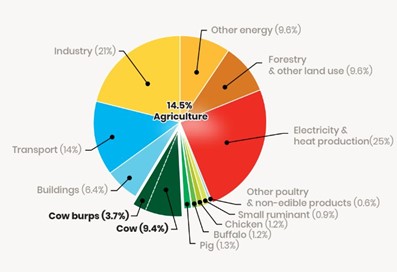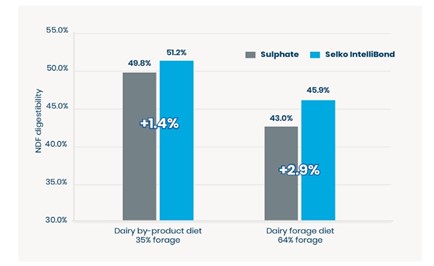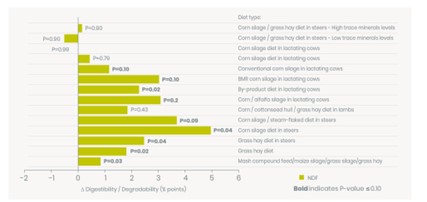Smart Mineral, Smart Nutrition, Smart Decision for Efficient growth
By: Dr. Maloshrie Bora, Program Manager – Mineral Nutrition, Trouw Nutrition South Asia
In the dynamic realm of animal nutrition, the role of minerals, especially microminerals, cannot be overemphasized. And this is where the strategic selection of minerals plays a pivotal role in driving efficient growth and maximizing performance. The term "smart minerals" embodies the essence of making informed and calculated decisions regarding the inclusion of essential micronutrients in animal diets. By understanding the nuanced roles of these minerals and their impact on overall nutrition, producers can pave the way for optimal growth, health, and productivity in their livestock.
Modifications in the ecosystem, driven by factors such as climate change, soil composition alterations, and agricultural practices, have significantly impacted the requirements of Trace Minerals (TM) in animal nutrition. These changes have led to shifts in nutrient availability, bioavailability, and absorption, influencing the dietary needs of animals.
An integral management of the farm should consider aspects related to the soil, pasture, and animal to ensure an adequate mineral nutrition. Here are some ways in which ecosystem modifications have influenced TM requirements in animal nutrition:
- Soil Depletion and Mineral Content: Intensive agricultural practices, including monoculture farming and excessive use of chemical fertilizers, have contributed to soil depletion, and reduced mineral content in forages. As a result, animals grazing on these lands may experience deficiencies in essential TM such as selenium, copper, and zinc, necessitating supplementation in their diets.
- Climate Change and Forage Quality: Changes in temperature, rainfall patterns, and CO2 levels can alter mineral uptake by plants, leading to variations in trace mineral concentrations in animal feeds. Producers must monitor and adjust mineral supplementation based on forage quality to meet animal requirements.
- Water Quality and Mineral Interactions: Alterations in water quality due to pollution, salinity, or mineral imbalances can impact mineral interactions and absorption in the animal's digestive system. Monitoring water sources and considering their mineral content is crucial for maintaining optimal TM levels in livestock.
- Industrial Pollution and Contaminant Exposure: Industrial activities can introduce contaminants affecting soil and water quality which interfere with mineral absorption and utilization in animals, leading to metabolic disorders. Implementing measures to mitigate pollutant exposure and providing clean, uncontaminated feed and water sources are essential for minimizing adverse effects on TM metabolism.
- Genetic Selection and Nutrient Requirements: Modern breeding practices focus on genetic selection for traits such as growth rate, milk production, and disease resistance. These genetic advancements can influence nutrient requirements, including TM, as animals with higher productivity levels may have increased metabolic demands. Tailoring diets based on genetic factors and performance metrics is crucial for meeting the evolving nutrient needs of genetically improved livestock.
- Supplementation Strategies and Nutrient Bioavailability: Given the complexities of ecosystem modifications, supplementation strategies for TM must be carefully planned. Utilizing bioavailable mineral sources, such as organic or chelated forms, can enhance absorption and utilization in animals, optimizing nutrient delivery and minimizing wastage.
Dairy cow nutrition plays a pivotal role in milk production, reproductive performance, and overall herd health. Among the essential nutrients, TM hold particular significance due to their involvement in various physiological processes. An integrated approach to assessing TM feeding practices in dairy cows is essential for optimizing production efficiency, ensuring animal welfare, and mitigating nutrient imbalances.
Importance of Trace Minerals in Dairy Cow Nutrition
Trace minerals (TM), including zinc, copper, selenium, manganese, and iodine, are critical for dairy cow health and productivity. These minerals participate in enzymatic reactions, immune function, antioxidant defence, and hormone synthesis. Deficiencies or excesses of TM can lead to reproductive disorders, impaired immune response, reduced milk production, and compromised hoof and udder health. Therefore, ensuring adequate but not excessive levels of TM in the diet is crucial for maintaining optimal cow performance and welfare.
Current Scenario of Trace Mineral Feeding management in Dairy Cows:
The role of Trace Minerals (TM) in the animal metabolism, dietary recommendations, current feeding practices, and their excretion in manure pertaining to five TM, i.e., cobalt, copper, iron, manganese, and zinc are the focus areas when discussing the impact of TM feeding management of dairy cows on the ecosystem. The transition period from the dry to the lactating phase is challenging for dairy cattle, and current trace mineral recommendations have been questioned for this period due to the role of some TM in immunity and oxidative metabolism. Furthermore, TM overfeeding is a common practice in intensive dairy production system which is far from precision nutrition. The practice of TM overfeeding could have detrimental effects on the ecosystem when manure with high TM concentrations is repeatedly spread on fields.
Challenges in Trace Mineral Feeding Practices:
Several challenges are associated with TM feeding practices in dairy cows. These challenges include variability in mineral content of feeds and forages, interactions between minerals affecting bioavailability, environmental factors influencing mineral status, and individual cow variability in nutrient requirements. Additionally, improper formulation or delivery of mineral supplements can result in wastage or inadequate intake by cows, impacting their nutritional status and overall health.
The Need for an Integrated Approach:
An integrated approach to TM feeding practices involves a comprehensive assessment of multiple factors to develop tailored nutrition strategies for dairy cows. This approach encompasses the following key elements:
- Nutrient Analysis and Monitoring:
- Conducting regular nutrient analysis of feeds, forages, and water sources to determine mineral content and potential deficiencies.
- Implementing monitoring protocols to assess cow mineral status through blood tests, milk analysis, or tissue sampling.
- Diet Formulation and Balancing:
- Formulating diets based on cow nutrient requirements, considering factors such as lactation stage, body condition, and production goals.
- Balancing mineral ratios to prevent antagonistic interactions and ensure optimal bioavailability and utilization.
- Environmental Management:
- Managing environmental factors that impact mineral availability, such as soil quality, water quality, and pasture management practices.
- Implementing soil amendments or supplementation strategies to address deficiencies in grazing areas.
- Supplementation Strategies:
- Selecting appropriate mineral supplements with high bioavailability and considering delivery methods (e.g., mineral blocks, top-dressing, TMR inclusion) to optimize intake and utilization.
- Adjusting supplementation levels based on seasonal variations, cow performance, and nutrient analysis results.
- Collaboration and Education:
- Collaborating with nutritionists, veterinarians, and extension specialists to develop and implement effective trace mineral feeding programs.
- Providing ongoing education and training to dairy farm personnel regarding best practices in trace mineral management and feeding.
Smart Recommendations for mineral supplementation:
Using large quantities of TM in herd management can have harmful impact on the environment if we continue to ignore it and work independently rather than in an integrated manner. The best way to reduce TM concentrations in manure is by achieving TM precision nutrition. However, there are several bottlenecks for TM precision nutrition. It should be no secret that a major push is underway in the animal nutrition industry to develop products, programs and practices that will significantly reduce the CO2 emissions of livestock. While much progress has been achieved, there is still a long way to go to achieve the objectives that various government and consumer groups have established as obtainable targets.
One key finding that has emerged so far is that it is highly unlikely that any one product, program or practice will, by itself, achieve the targeted CO2 reduction objectives that have been set. Rather, the quest to achieve a significant reduction in livestock-based CO2 emissions will need to be a group endeavour, with several products, programs and practices contributing to a successful outcome.
The use of certain feed additives to reduce CO2 emissions in dairy cattle is continuing to show promise, based on ongoing research results. When evaluating these additives, it is important to know how they function in the animal to support a lower carbon footprint. Few feed additives used in dairy cattle have been proven via independent research to significantly improve a dairy cow’s feed efficiency, thereby reducing the level of methane emissions produced per unit of productivity. Reviews of the results of different additives show that individual additives can deliver a reduction in the animal’s carbon footprint ranging from 2% to 12%. While this is positive, no single additive can deliver the 30% reduction the industry is being asked to deliver in the next five to ten years.
How can your TM program contribute to a reduction in CO2 levels in dairy cattle? Multiple studies conducted at several independent research locations have continued to demonstrate that when Selko IntelliBond Zinc, Copper and Manganese are used to replace Zn, Cu and Mn sulfate in dairy rations, neutral detergent fibre digestibility (NDFd) can be improved by approximately 2 points (see Figure 3). A comprehensive Life Cycle Assessment (LCA) was commissioned to understand the value of replacing sulfate-based TM with Selko IntelliBond Z, C and M on the cow’s carbon footprint. Results of the LCA indicated the ability of IntelliBond Z, C and M to help reduce the cow’s carbon footprint by up to 2% per kg of ECM (Energy Corrected Milk). Subsequent, independent review verified the findings of the LCA. IntelliBond Z, C and M is therefore the first family of trace minerals to be independently verified to assist with the reduction of the cow’s carbon footprint. The methane reduction targets that have been established by authorities and milk processors are certainly challenging and can’t be reached by only switching to Selko IntelliBond. The use of Selko IntelliBond is a positive, cost-effective step in the right direction. The reduction of methane emission that can be achieved with Selko IntelliBond does not increase the cost per kg of milk produced. Meeting targets for reduction of methane emissions will require an integrated approach, using a combination of indirect feed additives such as Selko Fytera Balance in combination with Selko IntelliBond. Combining these feed additives with improvements in nutrition, cow management, cow comfort, cropping systems and manure management will enable a dairy farmer to reach environmental targets set by the authorities and by milk processors, while preserving the financial well-being of the farm.

Fig 1: Global Greenhouse Gas Emissions by Economic Sector. Cattle farming is responsible for 9.4% of greenhouse gas emissions.

Fig 2: Methane Emission from Cows and other activities in a Dairy Farm. Over 40% of methane produced on a farm is related to rumen fermentation.

Fig 3: Selko IntelliBond fibre digestibility in cows on a low forage diet and in cows on a high forage diet.

Fig 4: Percentage improvement of Fibre Digestibility in cattle on different diets. A positive effect on fibre digestibility was found in 12 out of 14 studies. Each one-point difference in neutral detergent fibre (NDF) digestibility can represent 0.25 to 0.3 kg of daily Energy Corrected Milk production.
For further information, kindly write to us at customercareindia@trouwnutrition.com or visit our website: www.trouwnutrition.in